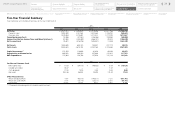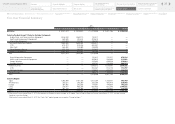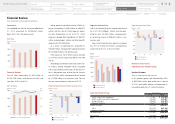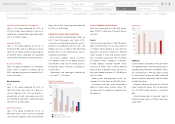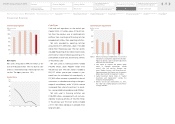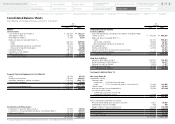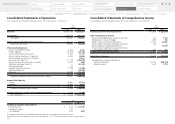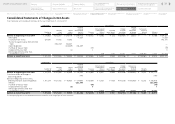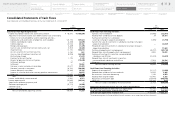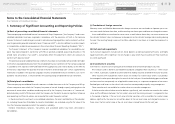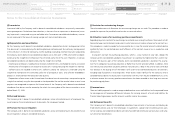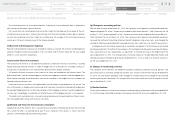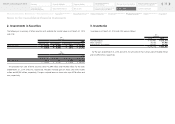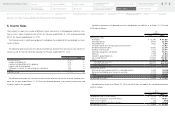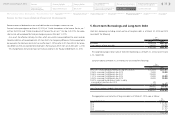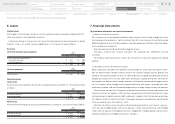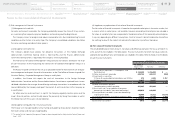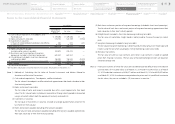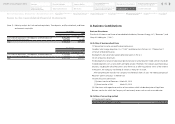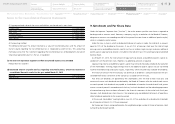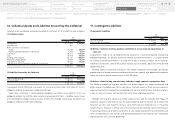Sharp 2015 Annual Report Download - page 36
Download and view the complete annual report
Please find page 36 of the 2015 Sharp annual report below. You can navigate through the pages in the report by either clicking on the pages listed below, or by using the keyword search tool below to find specific information within the annual report.
Notes to the Consolidated Financial Statements
(f) Inventories
Inventories held by the Company and its domestic consolidated subsidiaries are primarily measured at
moving average cost. For balance sheet valuation, in the event that an impairment is determined, inven-
tory impairment is computed using net realizable value. For overseas consolidated subsidiaries, invento-
ries are measured at the lower of moving average cost and net realizable value.
(g) Depreciation and amortization
For the Company and its domestic consolidated subsidiaries, depreciation of plant and equipment other
than lease assets is computed using the declining-balance method, except for machinery and equipment
at the LCD plants in Mie and Kameyama and the buildings (excluding attached structures) acquired by
the Company and its domestic consolidated subsidiaries on or after April 1, 1998; all of which are depre-
ciated using the straight-line method over the estimated useful life of the asset. Properties at overseas
consolidated subsidiaries are depreciated using the straight-line method.
Maintenance and repairs, including minor renewals and betterments, are charged to income as incurred.
Amortization of intangible assets except for lease assets is computed using the straight-line method.
Software costs are included in other assets. Software used by the Company is amortized using the
straight-line method over the estimated useful life of principally 5 years, and software embedded in
products is amortized over the forecasted sales quantity.
Depreciation of lease assets under finance leases that do not transfer ownership is computed using the
straight-line method, using the lease period as the depreciable life and the residual value as zero. Lease
payments are recognized as expenses for finance leases of the Company and its domestic consolidated
subsidiaries that do not transfer ownership for which the starting date of the lease transaction is on or
before March 31, 2008.
(h) Accrued bonuses
The Company and its domestic consolidated subsidiaries accrue estimated amounts of employees’ bo-
nuses based on the estimated amounts to be paid in the subsequent period.
(i) Provision for loss on litigation
The Company and its domestic consolidated subsidiaries accrue estimated amounts for possible future
loss on litigation in amounts considered necessary.
(j) Provision for restructuring charges
The estimated amounts of allowance for restructuring charges are set aside. This procedure is made to
provide for expenses for possible future loss due to structural reform.
(k) Valuation reserve for inventory purchase commitments
Regarding long-term contracts for purchasing raw materials over a long time frame, the amounts of dif-
ference between contracted price and current market price are set aside as allowance for contract loss.
This procedure is made to provide for future possible loss in case the market price of materials decline
significantly from the contracted price and fulfillment of the contract causes a loss in production and
sale business.
A long-term contract for purchasing polysilicon, which is a raw material of solar cells, obliges the
Company and its consolidated subsidiaries to purchase it at a significantly higher price than current mar-
ket price. The business plan of the Company and its consolidated subsidiaries is based on the assump-
tion that its obligation to purchase polysilicon at higher than market price be fulfilled. In addition, there
was intense price competition caused by overseas manufacturers, a drop in the price of solar panels due
to a decrease in the buying rate of the feed-in tariff system and a deteriorated business environment,
including large fluctuations in exchange rates. These factors made it difficult for the Company and its
consolidated subsidiaries to secure profit. In connection with this, from the year ended March 31, 2015,
a valuation reserve for inventory purchase commitments has been recorded as for a long-term contract
for purchasing polysilicon.
(l) Income taxes
The asset-liability approach is used to recognize deferred tax assets and liabilities for the expected future
tax consequences of temporary differences between the carrying amounts of assets and liabilities for
financial reporting purposes and the amounts used for income tax purposes.
(m) Retirement benefits
The Company and its domestic consolidated subsidiaries have primarily a trustee non-contributory de-
fined benefit pension plan for their employees to supplement a governmental welfare pension plan.
Certain overseas consolidated subsidiaries primarily have defined contribution pension plans and lump-
sum retirement benefit plans.
34
Notes to the Consolidated
Financial Statements
Financial Section
Segment Outline
Medium-Term Management Plan
for Fiscal 2015 through 2017
Investor Information
Directors, Audit & Supervisory Board
Members and Executive Officers
Risk Factors
Corporate Governance
Contents
Corporate Social
Responsibility (CSR)
Message to our Shareholders
Fiscal 2014 Review by
Product Group
Financial Highlights
SHARP Annual Report 2015
Consolidated
Subsidiaries
Independent Auditor’s
Report
Consolidated Statements of
Cash Flows
Consolidated Statements of
Changes in Net Assets
Consolidated Statements of
Comprehensive Income
Consolidated Statements of
Operations
Consolidated Balance Sheets
Financial Review
Five-Year Financial Summary


